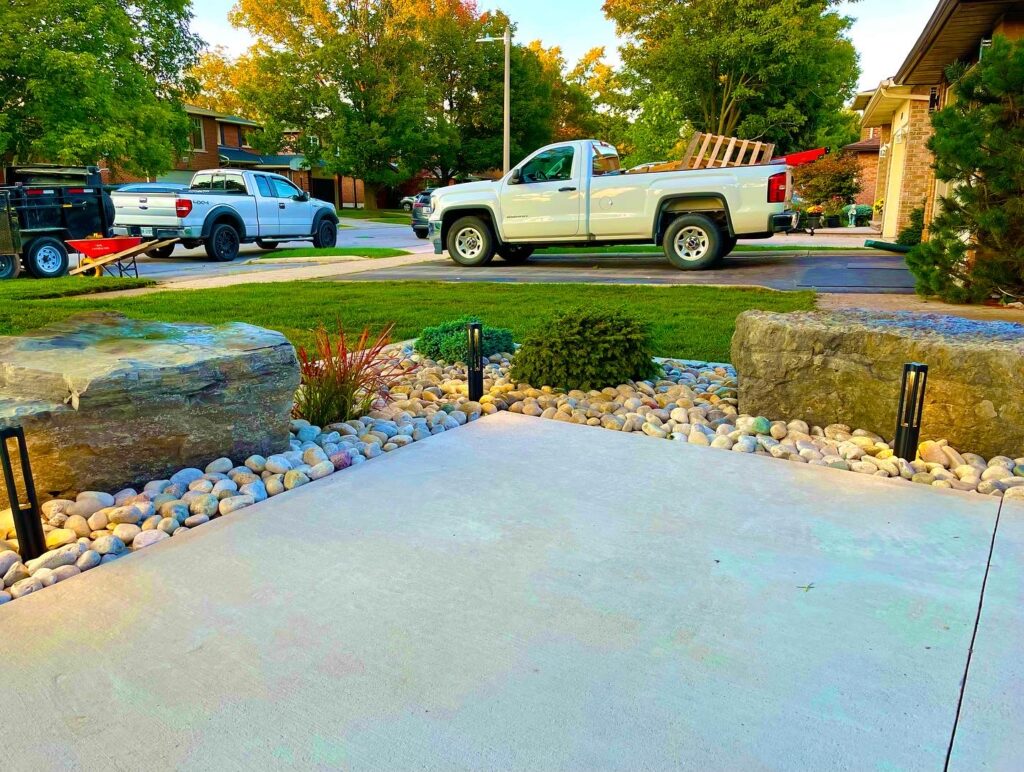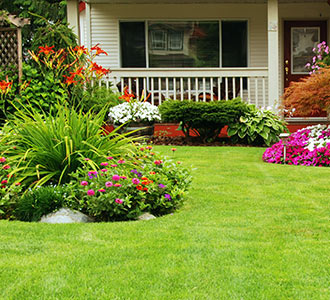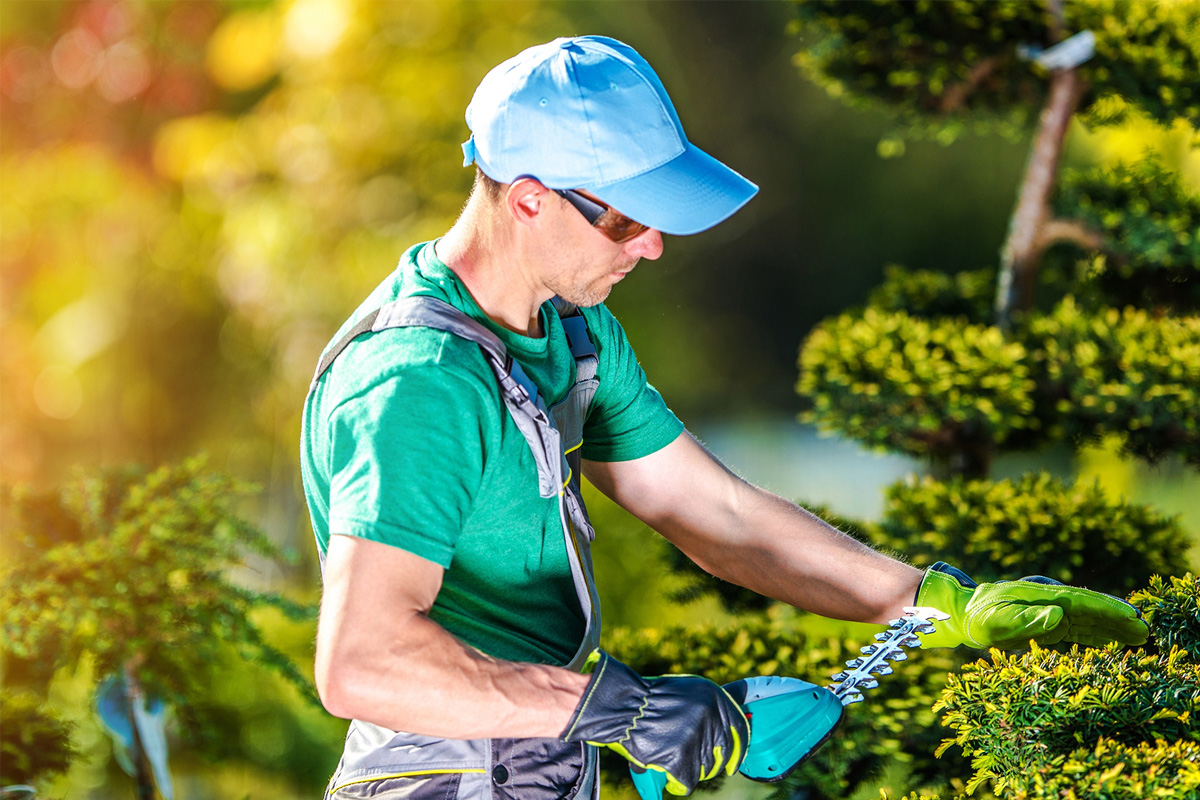Understanding the Comprehensive Extent of Functions in Specialist Landscaping Services
The considerable range of professional landscape design services encompasses a selection of fundamental aspects - landscaping. It consists of landscape design concepts, plant selection, and hardscaping attributes. Furthermore, it addresses watering systems and maintenance approaches. Each element plays a vital role in developing functional and cosmetically pleasing outdoor rooms. Understanding exactly how these components interact can reveal much regarding the art and science of landscape design. The trip into this detailed field is just starting.
Landscape Design Principles
Efficient landscape design principles are crucial for developing harmonious outside rooms that enhance both aesthetic allure and functionality (Learn More). These concepts lead the setup of components within the landscape, ensuring a cohesive aesthetic experience. Key components include balance, which disperses aesthetic weight equally; percentage, which associates the size of different aspects to every other and the space; and unity, which develops a feeling of integrity through consistent themes and materials

Plant Option and Setup
In the domain name of professional landscape design, plant option and installation play a critical function in attaining a prospering yard. Emphasizing native plant advantages, seasonal factors to consider, and the certain dirt and sunlight demands of each types assures a lasting and cosmetically pleasing landscape. Careful planning in these areas not just enhances biodiversity however also advertises long-term eco-friendly health.
Native Plant Advantages
Why should home owners consider native plants for their landscaping tasks? Indigenous plants offer various benefits that improve both visual appeals and environmental sustainability. They are well-adapted to neighborhood climates, requiring less water and maintenance compared to non-native types. This durability minimizes the demand for chemical plant foods and pesticides, promoting a healthier community. Furthermore, native plants supply environment and food for neighborhood wild animals, consisting of pollinators, which can raise biodiversity in residential areas. Their familiarity with local soil and weather also leads to much better growth rates and longevity. By picking indigenous plants, property owners not just produce aesthetically appealing landscapes yet likewise add to environmental conservation, making a favorable influence on their neighborhood atmosphere. As a result, native plants stand for a wise choice for landscape design tasks.
Seasonal Plant Considerations
House owners who have actually accepted native plants in their landscape design can better improve their exterior spaces by taking into consideration seasonal plant choices. By integrating plants that grow in details seasons, they can create vibrant and visually enticing landscapes throughout the year. Spring may introduce dynamic blooms like tulips and daffodils, while summertime can showcase rich foliage and vivid perennials. Fall introduces a scheme of warm tones with asters and goldenrods, while winter months can be highlighted with evergreens and decorative lawns for texture. Professional landscaping companies typically recommend choosing plants that not only enhance existing indigenous types yet likewise supply year-round interest and assistance local wildlife. This thoughtful strategy to seasonal plant choice assures a continually advancing and sustainable yard environment.
Soil and Sunshine Needs
Successful landscape design hinges on comprehending the specific soil and sunshine demands of plants. Different types prosper under varying conditions, needing a mindful assessment of both elements throughout the selection process. Soil kinds, such as sandy, clay, or fertile, influence drain, nutrition availability, and origin advancement. Furthermore, pH levels can influence plant wellness, demanding soil screening to identify suitability. Sunlight requirements differ substantially; some plants grow in complete sunlight, while others prefer partial or full color. A specialist landscaping company considers these elements to guarantee peak growth and aesthetic appeal. By aligning plant options with the atmosphere's certain features, landscapes can attain sustainability, strength, and aesthetic consistency, eventually causing successful plant establishment and long-term maintenance.
Hardscaping Features and Construction

While landscaping often stimulates photos of lush plant and dynamic blossoms, hardscaping functions play an essential duty in specifying outdoor rooms. These elements, that include patio areas, pathways, keeping wall surfaces, and ornamental stonework, provide structure and capability to gardens and yards. Hardscaping utilizes products such as concrete, timber, block, and stone, enabling diverse layouts that complement the all-natural landscape.
The building of hardscaping functions requires cautious preparation and implementation to guarantee resilience and visual appeal. Experts assess site problems, water drainage, and spatial connections to develop cohesive outside environments. Appropriate installment methods are essential, as they prevent problems like erosion and moving with time.
Integrating hardscaping not just boosts the visual interest of a property yet also helps with outside activities, making it an essential aspect of extensive landscape design services. Inevitably, thoughtful hardscaping contributes to both the functionality and charm of outside rooms.
Watering Systems and Water Management
Effective irrigation systems and water management are important elements of expert landscaping, as they guarantee that plants receive the necessary hydration for perfect growth. These systems can vary from easy drip irrigation setups to sophisticated automated lawn sprinkler systems, made to satisfy the certain requirements of diverse landscapes. Proper water management not just maximizes water use, lowering waste, however also boosts plant health and decreases condition threats.
Landscape design experts evaluate various factors, consisting of soil type, plant varieties, and local climate, to create customized irrigation services. In addition, integrating rainwater harvesting methods can better improve sustainability and efficiency. Regular maintenance of watering systems is important to keep performance and prevent leakages, which can result in water loss and increased expenses (Learn More). Ultimately, a properly designed watering system plays a pivotal role in preserving the aesthetic charm of exterior rooms while promoting environmental stewardship within specialist landscape design practices
Yard Treatment and Upkeep Strategies
Lawn care and maintenance methods are basic for achieving a lavish, healthy and balanced yard that improves the general landscape. These methods incorporate various practices targeted at promoting ideal development and visual allure. Normal mowing is important, as it encourages thick, even growth while protecting against weeds from developing. Additionally, appropriate fertilization supplies necessary nutrients, with applications tailored to the specific turf type and soil problems.
Watering techniques need to concentrate on deep, seldom watering to urge origin advancement, while aeration improves soil framework and promotes nutrition absorption. Bug and condition administration is likewise critical; recognizing problems early enables efficient treatments that reduce damage.
Overseeding can invigorate broken or slim yards, enhancing density and shade (landscaping services). By carrying out these targeted yard care techniques, landscaping specialists can assure that lawns stay healthy and vivid throughout the periods, greatly adding to the general charm of the property
Seasonal Landscape Treatment and Upkeep
As the periods change, appropriate landscape care becomes vital for keeping the health and beauty of exterior spaces. Each period presents distinct obstacles and demands. In springtime, landscape specialists concentrate on trimming, planting, and feeding to encourage development. Summer season demands routine watering, weed control, and insect management to protect freshly developed plants.

Throughout the year, seasonal landscape maintenance assurances that outside locations remain aesthetically enticing and healthy and balanced. Specialist services can provide tailored maintenance plans that adapt to the certain demands of each period, permitting property owners to delight in dynamic landscapes year-round. In general, seasonal care is a crucial element of professional landscaping that promotes longevity and aesthetic worth.

Lasting Landscape Design Practices
A growing variety of homeowner are accepting sustainable landscape design methods to create eco pleasant outside areas. These methods concentrate on preserving sources, enhancing biodiversity, and reducing ecological effect. Native plants are often picked for their low tide needs and compatibility with regional environments, minimizing the requirement for chemical fertilizers and pesticides. Rainfall gardens and absorptive paving are employed to take care of stormwater overflow, advertising groundwater recharge and decreasing disintegration.
Moreover, lasting landscaping includes organic horticulture strategies that prioritize dirt health and advertise natural bug control. Efficient watering systems, such as drip irrigation and rainwater harvesting, aid enhance water usage. Furthermore, landscape designers increasingly promote for the usage of recycled materials, such as recovered timber and stones, to lessen waste. By adopting these sustainable techniques, property proprietors not just contribute to environmental conservation yet also produce aesthetically pleasing environments that can love marginal upkeep.
Often Asked Questions
Just how Long Does a Landscaping Job Typically Take to Total?
Normally, a landscape design task can take anywhere from a few days to several weeks to complete, depending upon the job's dimension, layout, and intricacy demands. Aspects such as weather condition and resource schedule additionally influence timelines.
What Variables Impact the Expense of Landscaping Services?
Numerous factors affect landscape design solution prices, including job dimension, style complexity, worldly quality, labor expenses, geographical area, and seasonal demand. Each element contributes distinctively to the general monetary demands of a landscaping task.
Are Landscape Design Services Available Year-Round?
Landscape design services are generally readily available year-round, although availability may differ based upon region, seasonal climate conditions, and certain service offerings. Some services could be limited throughout extreme weather condition or off-peak periods.
Do Landscape Design Business Deal Guarantees on Their Work?
Lots of landscaping companies do supply service warranties on their job, which can vary in length and insurance coverage. Clients are motivated to ask about certain terms, ensuring they recognize what is guaranteed and any type of problems that apply.
Can I Style My Landscape Without Specialist Help?
Yes, individuals can create their landscapes without professional help. Nevertheless, they might do not have expertise in plant choice, format, and environmental considerations, possibly leading to less efficient styles that can require pricey adjustments later.
In the domain of expert landscaping, plant choice and installment play a crucial function in attaining a flourishing yard. Homeowners who have embraced native plants in their landscaping can additionally improve their exterior rooms by taking into consideration seasonal plant selections. Successful landscape design pivots on comprehending the certain dirt and sunlight needs of plants. Effective watering systems and water monitoring are essential parts of more info expert landscape design, as they ensure that plants get the required hydration for optimal growth. Landscaping specialists examine different elements, including dirt type, plant types, and neighborhood environment, to establish tailored watering options.